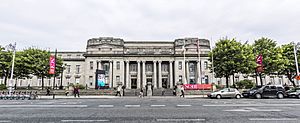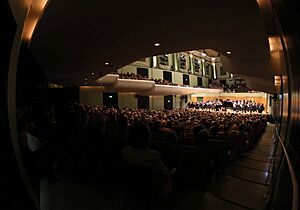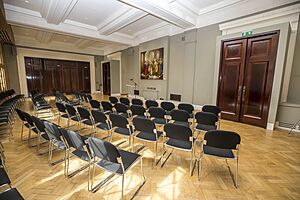National Concert Hall facts for kids
The National Concert Hall (NCH), also known as An Ceoláras Náisiúnta in Irish, is a special place for music in Ireland. Many people call it "the home of music in Ireland." Every year, over 1,000 events happen here in its different rooms.
The NCH is also home to Ireland's National Symphony Orchestra. Plus, it has three choirs: the National Symphony Chorus, Cor na nOg, and Cor Linn.
This building was first built in 1865 for a big exhibition. Later, in 1908, it became the main building for University College Dublin (UCD). In the 1960s, UCD moved to a new campus. Part of the old building was then changed into the National Concert Hall, which opened in 1981.
The NCH is a national cultural group. This means it gets help and money from the Irish Government. It is managed by a team and a special board chosen by the government.
Contents
The History of the Concert Hall
The area where the National Concert Hall stands is called Earlsfort Terrace. Its story began in 1865. Back then, it was known as the Exhibition Palace.
In 1871, the Guinness Family bought the buildings. They agreed that fun events could still happen there for ten more years. The Dublin Musical Society first performed at the Exhibition Palace in 1876. The famous Hallé Orchestra also played two concerts there in 1878.
The original building had a stone structure and a glass and steel Winter Garden. These parts were very costly to keep running. So, they were taken down and sold in 1882.
From 1883 to 1909, the Royal University of Ireland used the building. Concerts and small exhibitions still took place. In 1908, a new law created University College Dublin (UCD). The Royal University of Ireland then closed in 1909.
Links to Irish History
Some students and teachers from UCD were part of the Easter Rising in 1916. This was an important event in Irish history. One teacher, Thomas MacDonagh, was a leader in the Rising. He sadly died on May 3, 1916.
The building also has links to the War of Independence. Kevin Barry, a student at UCD, joined the Irish Republican Army.
After the Anglo-Irish Treaty was signed in 1921, the Dáil Éireann (Ireland's parliament) met in UCD's Council Chamber. This was between December 1921 and January 1922. They voted on the Treaty in UCD on January 7, 1922. The Treaty was approved by a small number of votes.
Becoming the NCH
In 1960, the Irish Government decided to build a new campus for UCD. This new campus was at Belfield. Then, in 1974, the government agreed to turn the Earlsfort Terrace site into the National Concert Hall. Work on this big project started in May 1978.
President Patrick Hillary officially opened the National Concert Hall on September 9, 1981. The RTÉ Symphony Orchestra, solo singers, and choirs performed. The Chieftains, a famous Irish traditional music group, gave the first traditional concert on September 11, 1981. The first solo piano concert was given by John O'Conor on September 12.
What You Can See and Hear
The National Concert Hall has many different types of music and performances. The International Concert Series is one of its most important programmes.
Another popular series is the Chamber Music Series. These concerts happen in The Kevin Barry Recital Room. They feature music from old styles like baroque to very new, modern music.
Performance Areas
The National Concert Hall has several different rooms where performances take place:
- The Main Auditorium can hold 1,200 people. It is used for large concerts and some operas.
- The John Field Room seats 250 people. It is used for smaller concerts and talks before a show.
- The Kevin Barry Recital Room holds 120 people. This room is home to the Chamber Music Series and other small concerts. It opened in 2016.
- The Studio can seat 100 people. It is used for talks before events, parties, and business meetings.
Groups That Call NCH Home
Many musical groups and other organisations are based at the National Concert Hall. They are called "resident bodies."
Musical Groups
National Symphony Orchestra
The National Symphony Orchestra started in 1948. It is one of Ireland's main classical music groups. They perform many live shows. They also help teach and guide young musicians. Since January 2022, the NSO has been part of the National Concert Hall. The NCH also took over RTÉ Cór na nÓg, RTÉ Vanbrugh Quartet, and RTÉ Philharmonic Choir.
Irish Baroque Orchestra
The Irish Baroque Orchestra plays music from the 1600s and 1700s. They became a resident group at the NCH in 2013.
Chamber Choir Ireland
Chamber Choir Ireland is a group of singers and is Ireland's national chamber choir. They have been based at the NCH since 2012. Their music ranges from very old Renaissance pieces to modern-day songs.
Crash Ensemble
Crash Ensemble started in 1997. The Washington Post newspaper called them an "Irish new-music collective." They have been a resident group at the NCH since 2014.
Other Groups
Music Network
Music Network has been based at the NCH since 2013. It is an organisation that helps music tours and development across Ireland. It started in 1986.
Music Generation
Music Generation is Ireland’s national programme for music education. It was started by Music Network. It gets money from famous groups like U2 and The Ireland Funds. It also gets support from the government. Like Music Network, it has been at the NCH since 2013.
Writers Block
Writer’s Block is a special area at the NCH with rooms for creative writing. It gives artists a quiet place to write, try new ideas, and work together. This helps the NCH support artists in creating new projects. As of 2021, artists like Paul Noonan, James Vincent McMorrow, and Lisa Hannigan are using these rooms.
Future Plans for the NCH
The National Concert Hall is going to be redeveloped. This big project is part of Project Ireland 2040. It is one of the Irish Government's main cultural plans.
Plans to improve the site have been in the works since the mid-2000s. The government wants to invest a lot of money to make the NCH a top place for music performances. Construction for this redevelopment was planned to start in 2022. It will involve changes to the buildings and performance spaces at Earlsfort Terrace.
See also
 In Spanish: Sala Nacional de Conciertos de Dublín para niños
In Spanish: Sala Nacional de Conciertos de Dublín para niños





